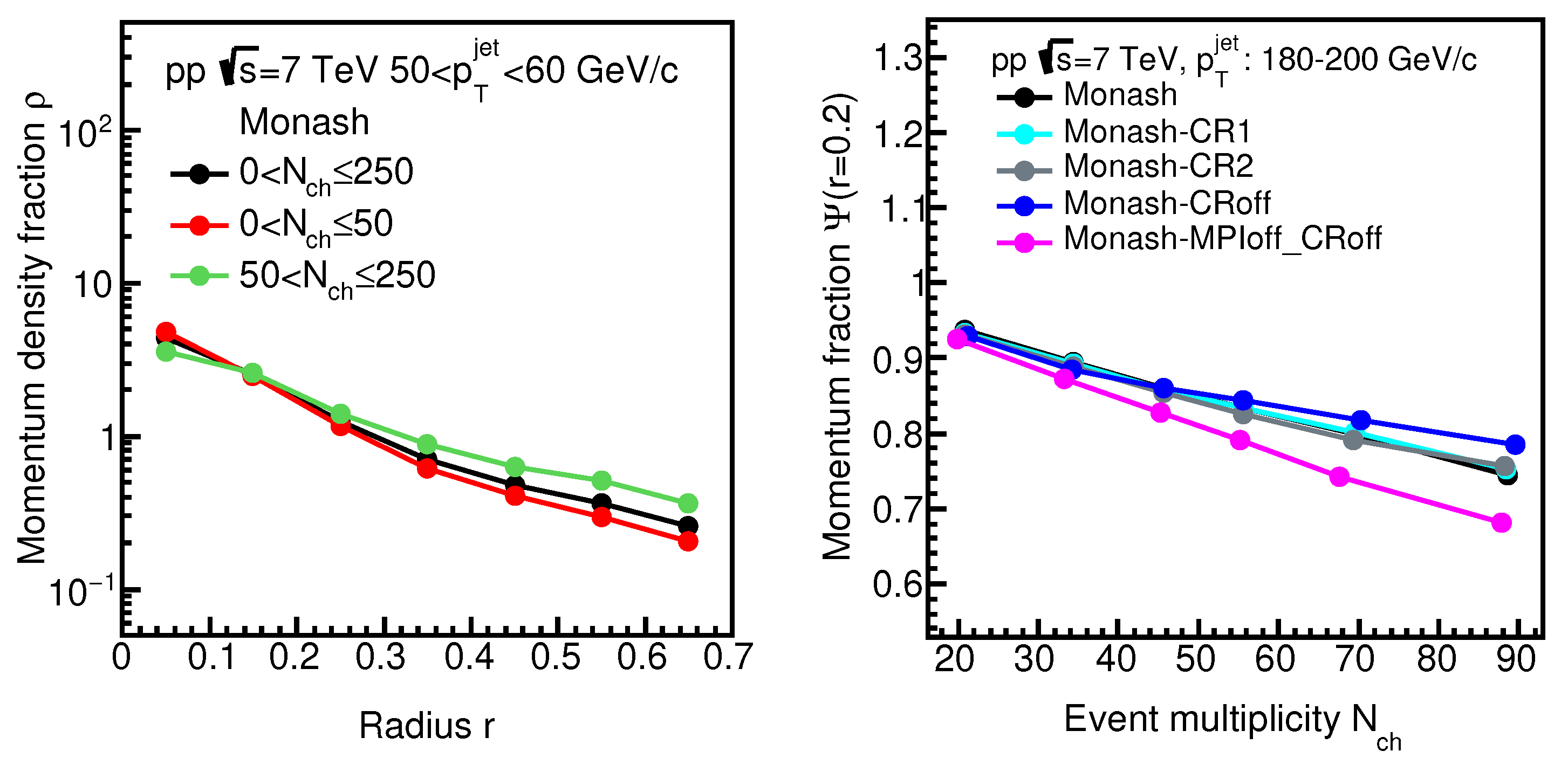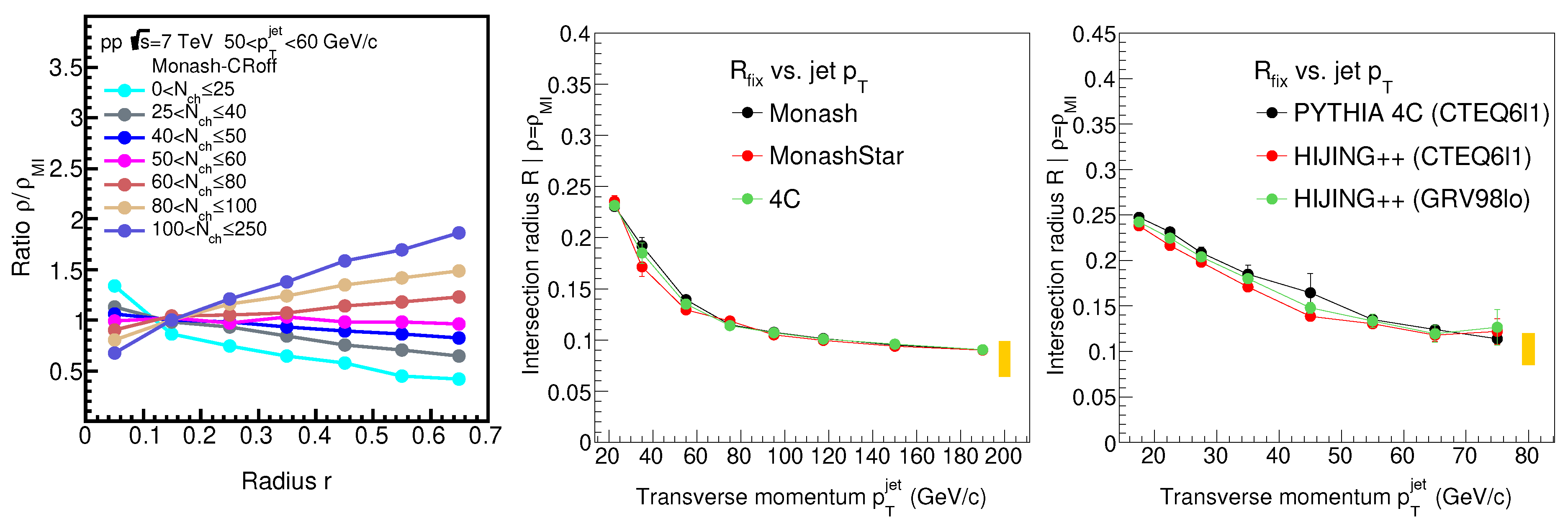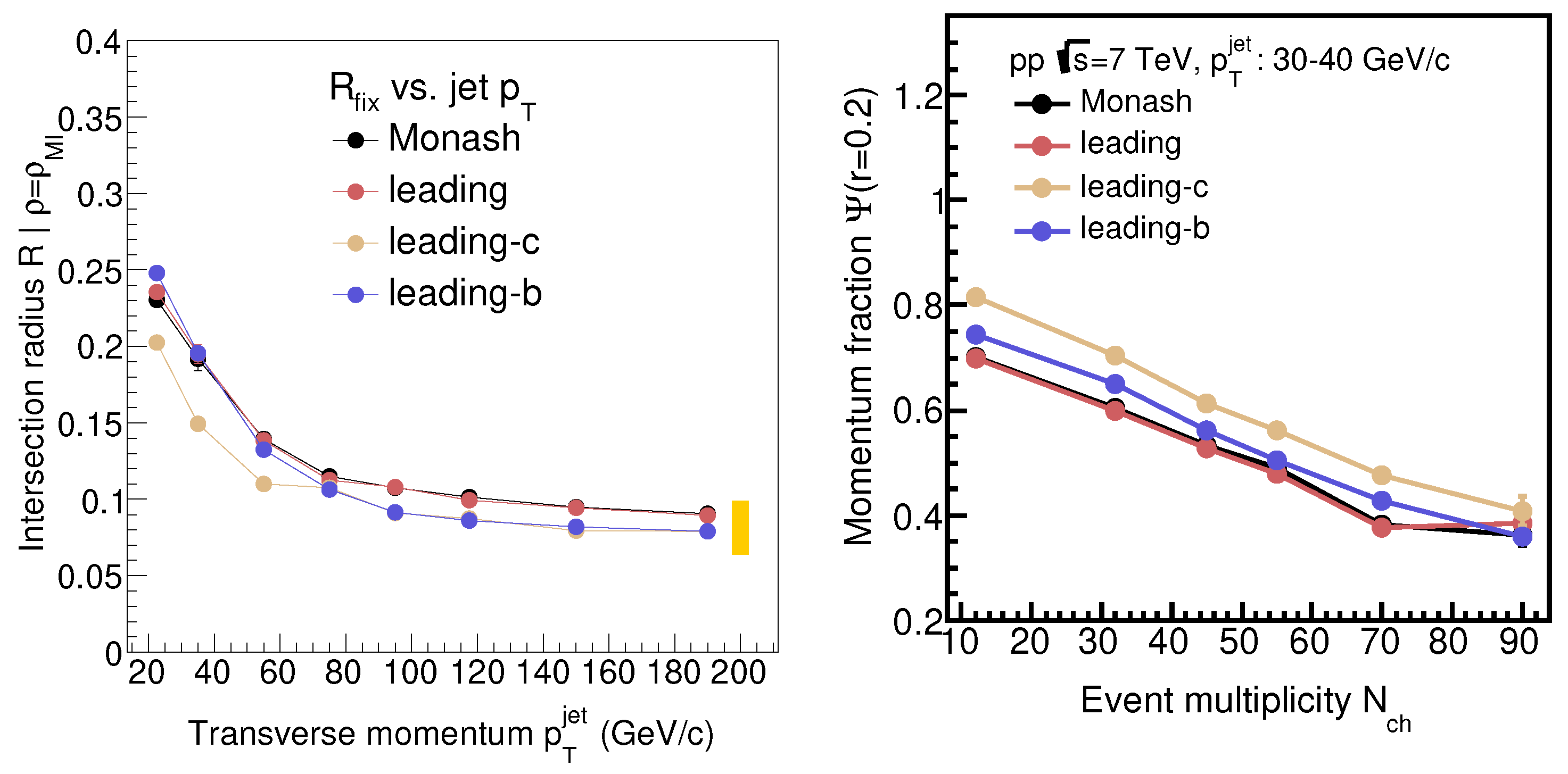Multiplicity Dependence of the Jet Structures in pp Collisions at LHC Energies †
Abstract
1. Introduction
2. Analysis and Results
3. Conclusions
Author Contributions
Funding
Acknowledgments
Conflicts of Interest
References
- Yan, L.; Ollitrault, J.Y. Universal fluctuation-driven eccentricities in proton-proton, proton-nucleus and nucleus-nucleus collisions. Phys. Rev. Lett. 2014, 112, 082301. [Google Scholar] [CrossRef]
- Khachatryan, V.; Sirunyan, A.M.; Tumasyan, A.; Adam, W.; Bergauer, T.; Dragicevic, M.; Erö, J.; Fabjan, C.; Friedl, M.; Frühwirth, R.; et al. Observation of Long-Range Near-Side Angular Correlations in Proton-Proton Collisions at the LHC. J. High Energy Phys. 2010, 1009, 91. [Google Scholar] [CrossRef]
- Dusling, K.; Li, W.; Schenke, B. Novel collective phenomena in high-energy proton–proton and proton–nucleus collisions. Int. J. Mod. Phys. E 2016, 25, 1630002. [Google Scholar] [CrossRef]
- Ortiz, A.; Bencédi, G.; Bello, H. Revealing the source of the radial flow patterns in proton–proton collisions using hard probes. J. Phys. G 2017, 44, 065001. [Google Scholar] [CrossRef]
- Varga, Z.; Vértesi, R.; Barnaföldi, G.G. Modification of jet structure in high-multiplicity pp collisions due to multiple-parton interactions and observing a multiplicity-independent characteristic jet size. arXiv 2018, arXiv:1805.03101. [Google Scholar] [CrossRef]
- Sjöstrand, T.; Ask, S.; Christiansen, J.R.; Corke, R.; Desai, N.; Ilten, P.; Mrenna, S.; Prestel, S.; Rasmussen, C.O.; Skands, P.Z. An Introduction to PYTHIA 8.2. Comput. Phys. Commun. 2015, 191, 159–177. [Google Scholar] [CrossRef]
- Barnaföldi, G.G.; Bíró, G.; Gyulassy, M.; Haranozó, S.M.; Lévai, P.; Ma, G.; Papp, G.; Wang, X.N.; Zhang, B.W. First Results with HIJING++ in High-Energy Heavy-Ion Collisions. Nucl. Part. Phys. Proc. 2017, 289–290, 373–376. [Google Scholar] [CrossRef][Green Version]
- Skands, P.; Carrazza, S.; Rojo, J. Tuning PYTHIA 8.1: The Monash 2013 Tune. Eur. Phys. J. C 2014, 74, 3024. [Google Scholar] [CrossRef]
- Ball, R.D.; Bertone, V.; Carrazza, S.; Del Debbio, L.; Forte, S.; Guffanti, A.; Hartland, N.P.; Rojo, J. Parton distributions with QED corrections. Nucl. Phys. B 2013, 877, 290–320. [Google Scholar] [CrossRef]
- Khachatryan, V.; Sirunyan, A.M.; Tumasyan, A.; Adam, W.; Asilar, E.; Bergauer, T.; Brandstetter, J.; Brondolin, E.; Dragicevic, M.; Erö, J.; et al. Event generator tunes obtained from underlying event and multiparton scattering measurements. Eur. Phys. J. C 2016, 76, 155. [Google Scholar] [CrossRef] [PubMed]
- Buckley, A.; Butterworth, J.; Gieseke, S.; Grellscheid, D.; Höche, S.; Hoeth, H.; Krauss, F.; Lönnblad, L.; Nurse, E.; Richardson, P.; Schumann, S. General-purpose event generators for LHC physics. Phys. Rep. 2011, 504, 145–233. [Google Scholar] [CrossRef]
- Pumplin, J.; Stump, D.R.; Huston, J.; Lai, H.L.; Nadolsky, P.M.; Tung, W.K. New generation of parton distributions with uncertainties from global QCD analysis. J. High Energy Phys. 2002, 0207, 012. [Google Scholar] [CrossRef]
- Cacciari, M.; Salam, G.P.; Soyez, G. FastJet user manual. Eur. Phys. J. C 2012, 72, 1896. [Google Scholar] [CrossRef]
- Chatrchyan, S.; Khachatryan, V.; Sirunyan, A.M.; Tumasyan, A.; Adam, W.; Bergauer, T.; Dragicevic, M.; Erö, J.; Fabjan, C.; Friedl, M.; et al. Shape, Transverse Size, and Charged Hadron Multiplicity of Jets in pp Collisions at 7 TeV. J. High Energy Phys. 2012, 1206, 160. [Google Scholar] [CrossRef]



© 2019 by the authors. Licensee MDPI, Basel, Switzerland. This article is an open access article distributed under the terms and conditions of the Creative Commons Attribution (CC BY) license (http://creativecommons.org/licenses/by/4.0/).
Share and Cite
Varga, Z.; Vértesi, R.; Barnaföldi, G.G. Multiplicity Dependence of the Jet Structures in pp Collisions at LHC Energies. Proceedings 2019, 10, 3. https://doi.org/10.3390/proceedings2019010003
Varga Z, Vértesi R, Barnaföldi GG. Multiplicity Dependence of the Jet Structures in pp Collisions at LHC Energies. Proceedings. 2019; 10(1):3. https://doi.org/10.3390/proceedings2019010003
Chicago/Turabian StyleVarga, Zoltán, Róbert Vértesi, and Gergely Gábor Barnaföldi. 2019. "Multiplicity Dependence of the Jet Structures in pp Collisions at LHC Energies" Proceedings 10, no. 1: 3. https://doi.org/10.3390/proceedings2019010003
APA StyleVarga, Z., Vértesi, R., & Barnaföldi, G. G. (2019). Multiplicity Dependence of the Jet Structures in pp Collisions at LHC Energies. Proceedings, 10(1), 3. https://doi.org/10.3390/proceedings2019010003




